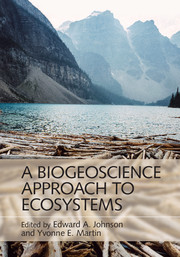Book contents
- Frontmatter
- Contents
- List of contributors
- Preface
- Miscellaneous Frontmatter
- 1 Introduction
- Part I Connecting Ecosystem and Geoscience Processes
- Part II Transport Processes and Conservation Budgets in Biogeoscience
- Part III Coupling Hillslope Geomorphology, Soils, Hydrology, and Ecosystems
- 5 Landscape Evolution Models and Ecohydrologic Processes
- 6 Soil Mantled Hillslopes: Intersections of Geomorphology, Soil Science, and Ecology
- 7 Interactions between Precipitation and Vegetation Canopies
- 8 Constraints on Nutrient Dynamics in Terrestrial Vegetation
- 9 Evapotranspiration
- Part IV Coupling Fluvial and Aeolian Geomorphology, Hydrology/Hydraulics, and Ecosystems
- Index
- References
5 - Landscape Evolution Models and Ecohydrologic Processes
from Part III - Coupling Hillslope Geomorphology, Soils, Hydrology, and Ecosystems
Published online by Cambridge University Press: 27 October 2016
- Frontmatter
- Contents
- List of contributors
- Preface
- Miscellaneous Frontmatter
- 1 Introduction
- Part I Connecting Ecosystem and Geoscience Processes
- Part II Transport Processes and Conservation Budgets in Biogeoscience
- Part III Coupling Hillslope Geomorphology, Soils, Hydrology, and Ecosystems
- 5 Landscape Evolution Models and Ecohydrologic Processes
- 6 Soil Mantled Hillslopes: Intersections of Geomorphology, Soil Science, and Ecology
- 7 Interactions between Precipitation and Vegetation Canopies
- 8 Constraints on Nutrient Dynamics in Terrestrial Vegetation
- 9 Evapotranspiration
- Part IV Coupling Fluvial and Aeolian Geomorphology, Hydrology/Hydraulics, and Ecosystems
- Index
- References
Summary
Introduction
Landscape can be broadly defined as a land area that comprises a physical (abiotic) topography component with an organized structure of hillslopes, valleys, and channels, and a biotic component including microorganisms, plants, animals, and humans that inhabit and influence this topographic platform. These landscape components are inherently coupled across a range of space and time scales. From the perspective of thermodynamic principles, landscapes can be viewed as open dissipative systems, with abiotic and biotic components exchanging mass, energy, and momentum within the basin template, co-organizing into dynamic and interacting structures (Fisher et al., 2007; Muneepeerakul et al., 2008; Rodríguez-Iturbe et al., 2009; del Jesus et al., 2012). Components of the system undertake distinctly different roles. Terrestrial ecosystems dictate the local land surface energy, water, and nutrient balance, and influence geomorphic processes (GP). The flows of water, sediments, nutrients, and organisms across the landscape are regulated by the network topology of a river basin, and in turn, they act as boundary conditions for the evolution of the river basin itself and its characteristic ecosystem (Murray et al., 2008; del Jesus et al., 2012). Complex interactions between abiotic and biotic landscape components have long been qualitatively recognized among scientists, however, such interactions remain largely unexplored quantitatively, as they lie in the interface among different disciplines such as biology, ecology, hydrology, and geology. An interdisciplinary research area, commonly referred to as “ecogeomorphology,” has emerged in the last couple of decades to study the coupled physical and biological processes of landscapes, and identify the emergent properties of the coupled system (Fisher et al., 2007; Murray et al., 2008; Reinhardt et al., 2010; Saco and Rodríguez, 2013).
Ecologists and hydrologists have researched to understand how the biota responds to the physical environment. Particular examples include the observed ecosystem differences in relation to landscape morphology at catchment scale (Hack and Goodlett, 1960; Swanson et al., 1988; Florinsky and Kuryakova, 1996; Ivanov et al., 2008b; Svoray and Karnieli, 2010; Jost et al., 2012; Flores-Cervantes et al., 2014), and the organization of ecosystems across regional climate and elevation gradients (Coblentz and Riitters, 2004; Caylor et al., 2005; Hillyer and Silman, 2010; Malhi et al., 2010).
- Type
- Chapter
- Information
- A Biogeoscience Approach to Ecosystems , pp. 135 - 179Publisher: Cambridge University PressPrint publication year: 2016
References
- 1
- Cited by



